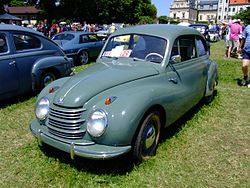- DKW F89
-
DKW Meisterklasse
DKW F89Manufacturer Auto Union AG Production 1950 – April 1954 Predecessor DKW F8 Successor DKW F91 Body style 2-door saloon
3-door ’Universal’ Estate
2-door cabrioletLayout FF layout Engine 684 cc two-stroke straight-2 [1] Transmission 3- or (from 1953) 4-speed manual Wheelbase 2,350 mm (93 in) (2-door)
2,450 mm (96 in) (Estate)Length 4,200 mm (170 in)
saloonCurb weight 860 kg (1,900 lb)- 900 kg (2,000 lb) (empty) Related DKW-Schnelllaster
IFA F9 The half brother. While Auto Union built the F89, in West Germany the Zwickau plant that had passed to the Soviets was producing the IFA F9. 30,000 or More IFA F9s had been produced initially at Zwickau and subsequently at Eisneach by 1956. Both western and eastern cars were closely based on the DKW F9 prototype first exhibited in 1939.
The half brother. While Auto Union built the F89, in West Germany the Zwickau plant that had passed to the Soviets was producing the IFA F9. 30,000 or More IFA F9s had been produced initially at Zwickau and subsequently at Eisneach by 1956. Both western and eastern cars were closely based on the DKW F9 prototype first exhibited in 1939.
The DKW Meisterklasse (English: "Master Class") also known as the DKW F89 was a compact front wheel drive saloon manufactured by Auto Union AG between 1950 and 1954. It was the first passenger car to be manufactured by the Auto Union company in West Germany following the re-establishment of the business in the west in 1949.
Contents
The Factory
Auto Union’s manufacturing plant had been located in Zwickau when war had put an end to passenger vehicle production in 1942. After the war, with Zwickau in the Soviet occupation zone, the company was no longer able to access its former production facilities. The first post war DKWs were therefore built in a refurbished plant of Rheinmetall-Borsig in Düsseldorf.
The Origins
The F89 shared its underpinnings with the DKW F8 / 'Meisterklasse' which had been available between 1939 and 1942, but the F89 has a steel body based on that of the DKW F9, a prototype which would have directly replaced the F8 on the Zwickau production lines had the war not intervened. Although many of the machine tools at that plant were crated up and shipped to the Soviet Union in 1945, Zwickau’s new controllers also built their own version of the DKW F9 prototype, and indeed the eastern version was put into production as the IFA F9, probably shortly before the Düsseldorf built F89. It is interesting to compare these two heirs to the original DKW prototype, and the ways in which their respective successor models evolved.
The F89 was not the first vehicle built by Auto Union after the war. That honor goes to the DKW F89L Schnelllaster / Quick truck, a curiously modern light van built on the same chassis and using the same engine / transmission package, introduced in 1949.
The Body
The form of the saloon’s body closely followed that of the prewar DKW F9. However, extensive ‘streamlining’ had been applied to the earlier design, and impressive claims were made for the F89’s lowered wind resistance.
In 1951 a two-seater hardtop coupe version, built by coach builders Hebmüller of Wuppertal became available, and the range was completed in 1953 with the addition of a three-door estate version, employing a body conversion that made extensive use of timber. The F89 estate, like its steel bodied, successors, was branded as the ‘Universal’.
Technical
The F89 featured a two-cylinder two-stroke engine of 684 cc with a stated output, at launch, of 23 bhp. A maximum speed of 100 km/h (62 mph) was claimed for the saloon (95 km/h / 59 mph for the 'Universal' estate). The engine was water-cooled, but there was no water pump. Cooling used a gravity powered ‘Thermosyphon’ system. The front wheels were connected to the engine by means of a three-speed manual gear box controlled via a dash-board mounted ‘Krückstockschaltung’ lever similar to that familiar to later generations from its application in the Citroen 2CV and Renault 4. Towards the end of the production run a four-speed manual box was offered on the Meisterklasse.
Data
Technical data DKW F89 / Meisterklasse [2] (Manufacturer's figures except where stated)F89 2-door saloon F89 3-door estate Produced: 1950–1954 1953 - Engine: 2-cylinder-inline engine (two-stroke), transversely front-mounted Bore x Stroke: 76 mm x 76 mm Displacement: 684 cc Max. Power @ rpm: 23 hp (17 kW) @ 4500 Cooling: Water cooling ‘Thermosyphon’ gravity powered Fuel feed: single Solex carburetor Transmission: 3-speed manual driving front wheels: 4-speed optional after 1953. Facia mounted control lever Body structure: Separate steel body on box-frame chassis Wheelbase: 2,350 mm (93 in) 2,450 mm (96 in) Track front/
rear:1,190 mm (47 in) 1,250 mm (49 in) 1,190 mm (47 in) 1,250 mm (49 in) Length: 4,200 mm (170 in) 4,055 mm (159.6 in) Width: 1,600 mm (63 in) 1,520 mm (60 in) Height: 1,450 mm (57 in) 1,555 mm (61.2 in) Dry weight: 860 kg (1,900 lb) 900 kg (2,000 lb) Tyre/Tire sizes: 5.50–16“ 1950–1953
5.60–15“ 1953–1954Sources and further reading
- ^ Gloor, Roger (1. Auflage 2007). Alle Autos der 50er Jahre 1945 - 1960. Stuttgart: Motorbuch Verlag. ISBN 978-3-613-02808-1.
- ^ Oswald, Werner (1. Auflage 2001). Deutsche Autos 1945-1990, Band 4. Stuttgart: Motorbuch Verlag. ISBN 3-613-02131-5.
- This article incorporates information from the equivalent article on the German Wikipedia.
Categories:- DKW vehicles
- Compact cars
- Front wheel drive vehicles
- 1950s automobiles
- Vehicles introduced in 1950
Wikimedia Foundation. 2010.


